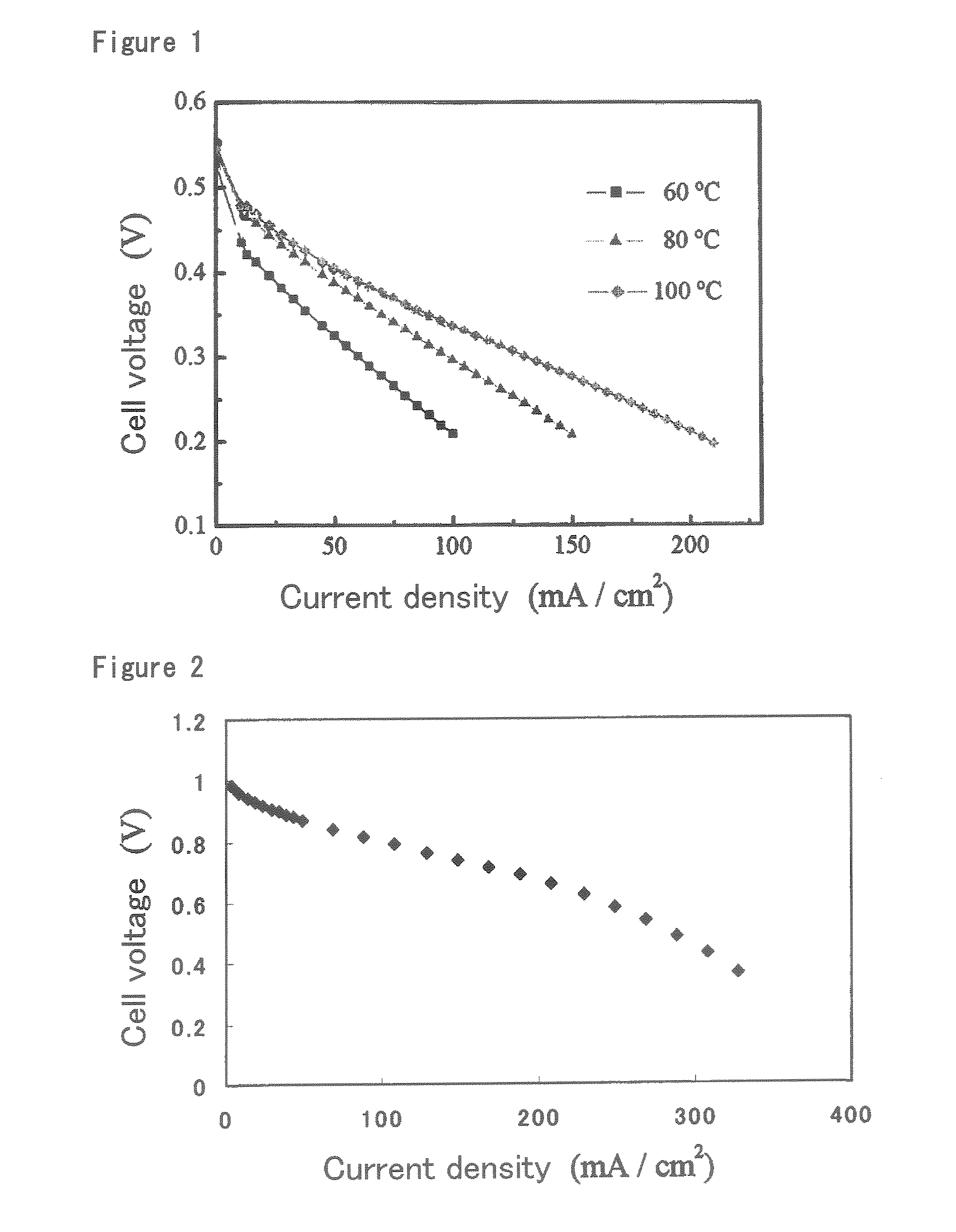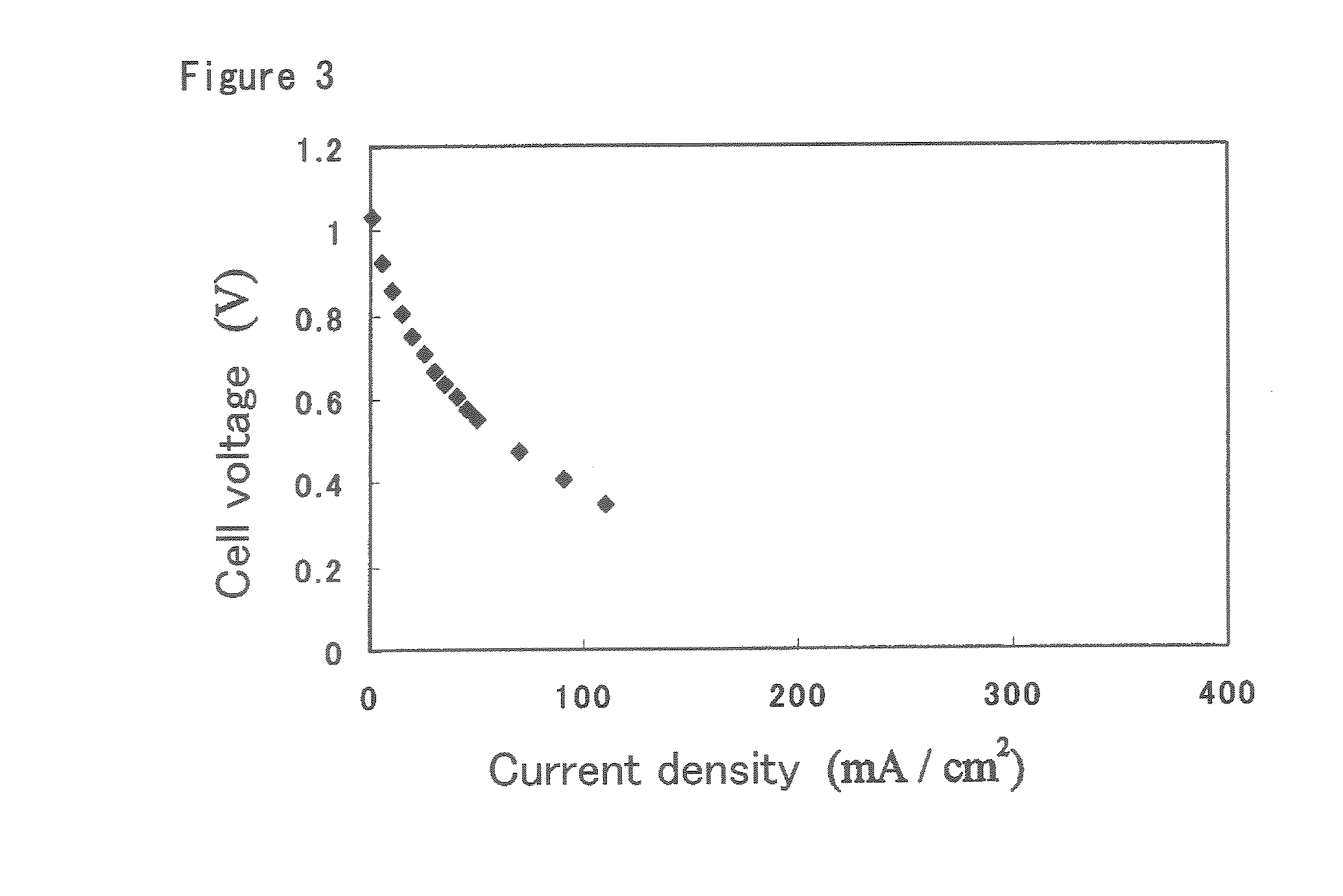Ion-Conductive Binder Membrane-Electrode Assembly and Fuel Cell
a technology of ion-conducting binder and ion-conducting membrane, which is applied in the direction of cell components, sustainable manufacturing/processing, and final product manufacturing, etc., can solve the problems of deterioration of electrodes, inability to secure sufficient operation time, and binders that cannot display sufficient cation conductivity, etc., to achieve high tensile strength, high tensile strength of ion-conducting binder, and sufficien
- Summary
- Abstract
- Description
- Claims
- Application Information
AI Technical Summary
Benefits of technology
Problems solved by technology
Method used
Image
Examples
referential example 1
[0112]Production of a block copolymer composed of poly (α-methylstyrene) (polymer block (A)) and hydrogenated polybutadiene (polymer block (B))
[0113]In a similar process to a previously reported process (JP-A-2001-172324), a poly (α-methylstyrene)-b-polybutadiene-poly (α-methylstyrene) triblock copolymer (hereinafter abbreviated as mSEBmS) was synthesized. The number average molecular weigh measurement, in terms of polystyrene) of the resulting mSEBmS was 74,000, and the amount of the 1,4-bond determined by 1H-NMR measurement was 56% and the content of the α-methylstyrene unit also determined by the 1H-NMR measurement was 28.6% by mass. Further, it was revealed by composition analysis through 1H-NMR spectrum measurement that α-methylstyrene was not substantially copolymerized into the polybutadiene block.
[0114]A solution of the synthesized inSEBmS in cyclohexane was prepared, the solution was put in a pressure proof vessel whose atmosphere had sufficiently been replaced with nitroge...
referential example 2
[0115]Production of a block copolymer composed of polystyrene (polymer block (A)) and polyisobutylene (polymer block (B))
[0116]A polystyrene-b-polyisobutylene-b-poly polystyrene triblock copolymer (hereinafter abbreviated as SiBuS) was prepared according to a previously reported process (JP-A-2000-159815). The number average molecular weight (GPC measurement, in terms of polystyrene) of the triblock copolymer was 68,000, and the content of styrene was 28.0%.
example 1
(1) Synthesis of a Sulfonated HmSEBmS
[0117]A sulfating reagent was prepared by reacting 25.2 ml of acetic anhydride with 11.2 ml of sulfuric acid at 0° C. in 50.2 ml of methylene chloride. Separately 100 g of the block copolymer obtained in Referential example 1 (HmSEBmS) was vacuum dried for 1 hour in a glass-made reaction vessel equipped with a stirrer, the inside atmosphere of the reaction vessel was replaced with nitrogen, 1,000 ml of methylene chloride was added, and the mixture was stirred at 35° C. for 2 hours to dissolve the block copolymer. After the dissolution, the sulfating reagent was gradually added dropwise over a period of 20 minutes. After stirring at 35° C. for 6 hours, the polymer solution was poured into 2 L of distilled water under stirring to coagulate and deposit the polymer. The deposited solid matter was washed with distilled water of 90° C. for 30 minutes, and then filtered. This operation of washing and filtration was repeated until the pH of the washings ...
PUM
| Property | Measurement | Unit |
|---|---|---|
| Temperature | aaaaa | aaaaa |
| Fraction | aaaaa | aaaaa |
| Fraction | aaaaa | aaaaa |
Abstract
Description
Claims
Application Information
 Login to View More
Login to View More - R&D
- Intellectual Property
- Life Sciences
- Materials
- Tech Scout
- Unparalleled Data Quality
- Higher Quality Content
- 60% Fewer Hallucinations
Browse by: Latest US Patents, China's latest patents, Technical Efficacy Thesaurus, Application Domain, Technology Topic, Popular Technical Reports.
© 2025 PatSnap. All rights reserved.Legal|Privacy policy|Modern Slavery Act Transparency Statement|Sitemap|About US| Contact US: help@patsnap.com



